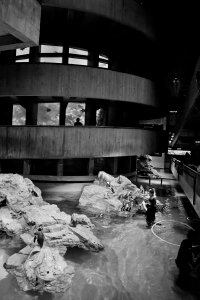Distinguishing between animal cruelty and animal activism
By Jessie Kuenzel
Staff Writer
After the astounding success of Gabriela Cowperthwaite’s documentary “Blackfish,” which shed a national spotlight on the already highly contested business of keeping marine mammals in captivity, and the rapidly growing movement of animal rights activists, aquatic theme-parks like SeaWorld have found themselves—ironically enough—in very hot water.
The public mood has shifted drastically in recent years; between the graphic and disturbing accusations of animal mistreatment, and the spike in interest for marine mammal welfare, the public is no longer content just to file blindly into their seats at SeaWorld and buy their “I Saw Shamu” shirts on the way out.
As the issue has gained more traction in the media, many have adopted a blanket attitude of “anywhere that keeps animals in captivity is bad.” And while the criticism of these for-profit businesses is inarguably valid, there are many non-profit institutions that not only maintain the highest quality living conditions for their aquatic charges, but also are often running invaluable research, education, and conservation programs.
In his article “Zoos and Aquariums Do Not Accomplish What They Claim They Do” on pyschologytoday.com, Professor Marc Bekoff of the University of Colorado questions why “people should visit [zoos and aquariums] rather than watch videos of wild animals, observe the animals with whom they share their homes, or simply take walks in nature and enjoy the fauna and flora they see, hear, and smell.”
And while playing with the family dog is always a fun time, if Bekhoff can’t understand the difference in value between taking Fido for a walk through the neighborhood park while watching a pair of squirrels frolic in the grass and going to your local non-profit aquarium and getting a firsthand look at the deep-sea ecosystems that are dying off due to climate change, overfishing, and pollution, it’s quite possible he doesn’t grasp the nuances of conservation education.
Non-profit aquariums are wildly different creatures from these entertainment-centric institutions that have honed their business models to yield maximum profit margins with minimum animal care.

It is quite possible to visit an aquarium and enjoy the beauty of aquatic life without feeling guilty. There are places that you can frequent where, rather than worrying about whether your dollars are contributing to animal cruelty and lining the pockets of rich businessmen, you know your money is directly funding research, education, and outreach.
Before you entirely write off your local aquarium or zoo, do a bit of research and ask yourself the following questions:
• Is the institution non-profit?
• Does the institution have several active conservation and/or research programs?
• Does the institution have an
active animal rescue/rehabilitation program?
• Do the animals seem healthy and well taken care of?
• Does the institution place an
emphasis on education and conservation in their exhibits?
If the answers to all these questions are yes, hop on the next bus, train, or into your car and go enjoy a day learning about conservation with some nifty animals.



















